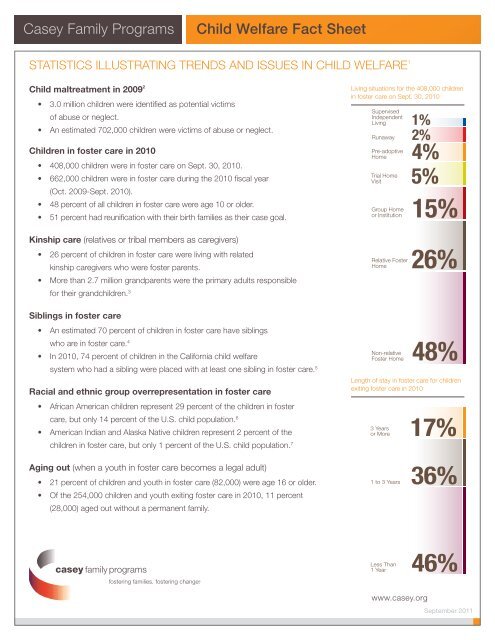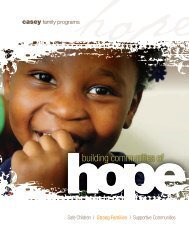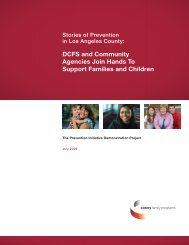Casey Family Programs Child Welfare Fact Sheet
Casey Family Programs Child Welfare Fact Sheet
Casey Family Programs Child Welfare Fact Sheet
Create successful ePaper yourself
Turn your PDF publications into a flip-book with our unique Google optimized e-Paper software.
<strong>Casey</strong> <strong>Family</strong> <strong>Programs</strong> <strong>Child</strong> <strong>Welfare</strong> <strong>Fact</strong> <strong>Sheet</strong><br />
StatiSticS iLLuStrating trendS and iSSueS in chiLd weLfare 1<br />
<strong>Child</strong> maltreatment in 2009 2<br />
• 3.0 million children were identified as potential victims<br />
of abuse or neglect.<br />
• An estimated 702,000 children were victims of abuse or neglect.<br />
<strong>Child</strong>ren in foster care in 2010<br />
• 408,000 children were in foster care on Sept. 30, 2010.<br />
• 662,000 children were in foster care during the 2010 fiscal year<br />
(Oct. 2009-Sept. 2010).<br />
• 48 percent of all children in foster care were age 10 or older.<br />
• 51 percent had reunification with their birth families as their case goal.<br />
Kinship care (relatives or tribal members as caregivers)<br />
• 26 percent of children in foster care were living with related<br />
kinship caregivers who were foster parents.<br />
• More than 2.7 million grandparents were the primary adults responsible<br />
for their grandchildren. 3<br />
Siblings in foster care<br />
• An estimated 70 percent of children in foster care have siblings<br />
who are in foster care. 4<br />
• In 2010, 74 percent of children in the California child welfare<br />
system who had a sibling were placed with at least one sibling in foster care. 5<br />
Racial and ethnic group overrepresentation in foster care<br />
• African American children represent 29 percent of the children in foster<br />
care, but only 14 percent of the u.S. child population. 6<br />
• American Indian and Alaska Native children represent 2 percent of the<br />
children in foster care, but only 1 percent of the u.S. child population. 7<br />
Aging out (when a youth in foster care becomes a legal adult)<br />
• 21 percent of children and youth in foster care (82,000) were age 16 or older.<br />
• Of the 254,000 children and youth exiting foster care in 2010, 11 percent<br />
(28,000) aged out without a permanent family.<br />
Living situations for the 408,000 children<br />
in foster care on Sept. 30, 2010<br />
Length of stay in foster care for children<br />
exiting foster care in 2010<br />
www.casey.org<br />
September 2011
<strong>Casey</strong> <strong>Family</strong> <strong>Programs</strong> <strong>Child</strong> <strong>Welfare</strong> <strong>Fact</strong> <strong>Sheet</strong><br />
1 Except where footnoted, data are for the period ending September 30, 2010 and were taken from figures available from the Adoption and Foster Care Analysis and<br />
Reporting System (AFCARS). Retrieved September 9, 2011 from http://www.acf.hhs.gov/programs/cb/stats_research/afcars/trends.htm and http://www.acf.hhs.gov/<br />
programs/cb/stats_research/afcars/tar/report18.htm<br />
2 These figures represent unduplicated children. U.S. Department of Health and Human Services, Administration for <strong>Child</strong>ren and Families, Administration on <strong>Child</strong>ren, Youth<br />
and Families, <strong>Child</strong>ren’s Bureau. (2010). <strong>Child</strong> Maltreatment 2009. Available from http://www.acf.hhs.gov/programs/cb/stats_research/index.htm#can.<br />
3 United States American Community Survey 2010. Table B10056 Living with own grandchildren under 18 years. Retrieved September 22, 2011 from http://factfinder2.<br />
census.gov<br />
4 Shlonsky, A.R., Elkins, J., Bellamy, J.L. & Ashare, C.J. 2005. Introduction to the special issue on siblings and foster care. <strong>Child</strong>ren and Youth Services Review, 27(7):<br />
693–695.<br />
5 Needell, B., Webster, D., Armijo, M., Lee, S., Dawson, W., Magruder, J., Exel, M., Cuccaro-Alamin, S., Putnam-Hornstein, E., Williams, D., Simon, V., Hamilton, D., Lou,<br />
C., Peng, C., Moore, M., Jacobs, L., & King, B. (2011) <strong>Child</strong> <strong>Welfare</strong> Services Reports for California. Retrieved September 9, 2011 from University of California at Berkeley<br />
Center for Social Services Research website. URL: http://cssr.berkeley.edu/CWSCMSreports/<br />
6 Data on child population by race for 2009 were retrieved from the KIDS COUNT Data Center at http://datacenter.kidscount.org/data/acrossstates/Rankings.aspx?ind=103<br />
on September 9, 2011.<br />
7 Ibid.<br />
<strong>Child</strong> <strong>Welfare</strong> <strong>Fact</strong> <strong>Sheet</strong> can be found online at: www.casey.org/factsheet




